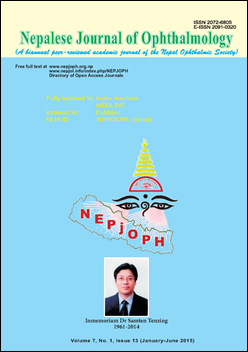Epidemiology and etiological diagnosis of infective keratitis in eastern region of Nepal
DOI:
https://doi.org/10.3126/nepjoph.v7i1.13146Keywords:
Corneal ulcer, suppurative, keratitis, corneal trauma, fungal keratitis, preventable blindness, corneal opaci¿cationAbstract
Objective: This study aimed to determine the epidemiological characteristics and risk factors predisposing to corneal ulceration in patients presenting to Biratnagar Eye Hospital (Nepal).
Methods: All patients presenting to Biratnagar Eye Hospital between January 1 and December 31, 2011 with corneal ulceration were retrospectively reviewed. Sociodemographic data and information pertaining to risk factors were recorded, all patients were examined and corneal scrapping and cultures were carried out.
Results: Over one year period 1644 patients with corneal ulcer were evaluated, out of which 76.6% of patients were in the age range of 30 to 69 years and 65% of patients had presenting visual acuity < 3/60. Ocular trauma was the most common cause of keratitis accounting for 60.3% of corneal ulcer and majority of the patients (40%) presented after 2 weeks of symptoms. Among corneal scraping positive cases 1150 (70%) showed fungus, 73 (4.4%) showed bacteria and 20 (1.2%) showed both bacterial and fungus.
Conclusion: Corneal ulcer continues to be one of the leading causes of preventable blindness in this region. Lack of awareness about gravity of this disease, financial constraints and geographic barriers remain the major reasons for delay in seeking proper medical help.
Downloads
Downloads
Published
How to Cite
Issue
Section
License
This license enables reusers to copy and distribute the material in any medium or format in unadapted form only, for noncommercial purposes only, and only so long as attribution is given to the creator.




